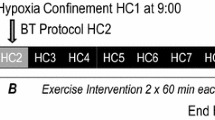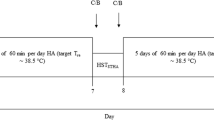Abstract
This study examined the effectiveness of endurance training and heat acclimation in reducing the physiological strain imposed by exercising in the heat while wearing protective clothing. Seven young men underwent 8 weeks of physical training [60–80% maximal aerobic power (VO2max) for 30–45 min · day−1, 3–4 days · week−1 at < 25° C] followed by 6 days of heat acclimation (45–55% VO2max for 60 min · day−1 at 40° C, 30% relative humidity). Nine other young men underwent corresponding periods of control observation and heat acclimation. Before and after each treatment, subjects completed a treadmill walk (4.8 km · h−1, 2% grade) in a climatic chamber (40° C, 30% relative humidity), wearing in turn normal combat clothing or clothing protecting against nuclear, biological, and chemical (NBC) agents. Criteria for halting this test were: (1) a rectal temperature (T re) of 39.3° C; (2) a heart rate (f c) ≥ 95% of the subject's observed maximum, maintained for 3 min; (3) unwillingness of the subject to continue; (4) the elapse of 120 min. The training regimen increased mean VO2max by 16% and mean plasma volume by 8%. When tested in normal combat clothing, the rates of increase in T re and f c were slower after training. However, when wearing NBC protective clothing, the only significant change induced by training was a higher mean skin temperature (T sk) in the early part of the test. Heat acclimation increased the mean plasma volume of untrained subjects by 8%, but their VO2max remained unchanged. When tested in normal combat clothing, acclimation decreased their mean values of T re, T sk, f c, and metabolic rate. When wearing NBC protective clothing, the only significant decrease after acclimation was in overall T re. In trained subjects, heat acclimation induced no further improvement in any physiological variable when wearing normal combat clothing, but reduced overall T re and T sk when wearing NBC protective clothing. Training- or acclimation-induced increases of sweat secretion (an average increment of 0.14–0.23 kg · h−1) were not accompanied by any statistically significant increase in sweat evaporation when wearing NBC protective clothing. Moreover, tolerance times were unchanged in either normal combat (116–120 min) or NBC protective clothing (47–52 min). We conclude that neither endurance training nor heat acclimation do much to improve exercise tolerance when wearing NBC protective clothing in hot environments, because any added sweat secretion decreases blood volume and increases discomfort without augmenting body cooling.
Similar content being viewed by others
References
Birnbaum RR, Crockford GW (1978) Measurement of the clothing ventilation index. Appl Ergonomics 9:194–200
Craig FN, Moffitt JT (1974) Efficiency of evaporative cooling from wet clothing. J Appl Physiol 36:313–316
Dill DB, Costill DL (1974) Calculation of percentage changes in volumes of blood, plasma, and red cells in dehydration. J Appl Physiol 37:247–248
Dimri GP, Malhotra MS, Sen Gupta J, Sampath Kumar T, Arora BS (1980) Alterations in aerobic-anaerobic proportions of metabolism during work in heat. Eur J Appl Physiol 45:43–50
DuBois D, DuBois EF (1916) A formula to estimate the approximate surface area if height and weight be known. Arch Intern Med 17:863–871
Duggan A (1988) Energy cost of stepping in protective clothing ensembles. Ergonomics 31:3–11
Fellmann N (1992) Hormonal and plasma volume alterations following endurance exercise: a brief review. Sports Med 13:37–49
Gagge AP, Nishi Y (1983) Heat exchange between human skin surface and thermal environment. In: Lee DHK (ed) Handbook of physiology: reactions to environmental agents. American Physiological Society, Bethesda, pp 69–92
Gisolfi CV, Wenger CB (1984) Temperature regulation during exercise: old concepts, new ideas. In: Terjung RL (ed) Exercise and Sport Sciences Reviews, vol 12. American College of Sports Medicine, New York, pp 339–372
Goldman RF (1985) Heat stress in industrial protective encapsulating garments. In: Levine SP, Martin WF (eds) Protecting personnel at hazardous waste sites. Butterworth, Boston, pp 215–266
Goldman RF (1988) Standards for human exposure to heat. In: Mekjavic IB, Banister EW, Morrison JB (eds) Environmental ergonomics: sustaining human performance in harsh environments. Taylor and Francis, Philadelphia, pp 99–136
Harrison MH (1985) Effects of thermal stress and exercise on blood volume in humans. Physiol Rev 65:149–209
Kakitsuba N, Gaul K, Michna H, Mekjavić IB (1988) Dynamic moisture permeation through clothing. Aviat Space Environ Med 59:49–53
King DS, Costill DL, Fink WJ, Hargreaves M, Fielding RA (1985) Muscle metabolism during exercise in the heat in unacclimatized and acclimatized humans. J Appl Physiol 59:1350–1354
Kirwan JP, Costill DL, Kuipers H, Burrell MJ, Fink WJ, Kovaleski JE, Fielding RA (1987) Substrate utilization in leg muscle of men after heat acclimation. J Appl Physiol 63:31–35
Knochel JP (1989) Heat stroke and related heat stress disorders. DM 35:301–378
Louhevaara VA (1984) Physiological effects associated with the use of respiratory protective devices: a review. Scand J Work Environ Health 10:275–281
Maughan RJ, Noakes TD (1991) Fluid replacement and exercise stress: a brief review of studies on fluid replacement and some guidelines for the athlete. Sports Med 12:16–31
McArdle WD, Katch FT, Katch VL (1991) Exercise physiology: energy, nutrition, and human performance, 3rd edn. Lea and Febiger, Philadelphia, pp 44–67
McLellan TM, Meunier P, Livingstone S (1992) Influence of a new vapor protective clothing layer on physical work tolerance times at 40° C. Aviat Space Environ Med 63:107–113
Mitchell JW, Nadel ER, Stolwijk JAJ (1972) Respiratory weight losses during exercise. J Appl Physiol 32:474–476
Morgan WP (1983) Hyperventilation syndrome: a review. Am Ind Hyg Assoc J 44:685–689
Nadel ER, Pandolf KB, Roberts MF, Stolwijk JAJ (1974) Mechanisms of thermal acclimation to exercise and heat. J Appl Physiol 37:515–520
Nadel ER, Cafarelli E, Roberts MF, Wenger CB (1979) Circulatory regulation during exercise in different ambient temperatures. J Appl Physiol 46:430–437
Nielsen B (1969) Thermoregulation in rest and exercise. Acta Physiol Scand [Suppl] 323:1–74
Nielsen B, Savard G, Richter EA, Hargreaves M, Saltin B (1990) Muscle blood flow and muscle metabolism during exercise and heat stress. J Appl Physiol 69:1040–1046
Nunneley SA (1988) Design and evaluation of clothing for protection from heat stress: an overview. In: Mekjavic IB, Banister EW, Morrison JB (eds) Environmental ergonomics: sustaining human performance in harsh environments. Taylor and Francis, Philadelphia, pp 87–98
Nunneley SA (1989) Heat stress in protective clothing: interactions among physical and physiological factors. Scand J Work Environ Health 15 [Suppl 1]:52–57
Nunneley SA, Antuñano MJ, Bomalaski SH (1992) Thermal convergence fails to predict heat tolerance limits. Aviat Space Environ Med 63:886–890
Pandolf KB, Goldman RF (1978) Convergence of skin and rectal temperatures as a criterion for heat tolerance. Aviat Space Environ Med 49:1095–1101
Plyley MJ, Shephard RJ, Davis GM, Goode RC (1987) Sleep deprivation and cardiorespiratory function: influence of intermittent submaximal exercise. Eur J Appl Physiol 56:338–344
Raven PB, Dodson AT, Davis TO (1979) The physiological consequences of wearing industrial respirators: a review. Am Ind Hyg Assoc J 40:517–534
Roberts MIT, Wenger CB, Stolwijk JAJ, Nadel ER (1977) Skin blood flow and sweating changes following exercise training and heat acclimation. J Appl Physiol 43:133–137
Rodwell VW (1988) Enzymes: kinetics. In: Murray RK, Granner DK, Mayes PA, Rodwell VW (eds) Harper's biochemistry, 21st edn. Appleton and Lange, Norwalk, pp 61–74
Sawka MN (1988) Body fluid responses and hypohydration during exercise-heat-stress. In: Pandolf KB, Sawka MN, Gonzalez RR (eds) Human performance physiology and environmental medicine at terrestrial extremes. Benchmark, Indianapolis, pp 227–266
Sawka MN, Wenger CB (1988) Physiological responses to acute exercise-heat stress. In: Pandolf KB, Sawka MN, Gonzalez RR (eds) Human performance physiology and environmental medicine at terrestrial extremes. Benchmark, Indianapolis, pp 97–151
Sawka MN, Pandolf KB, Avellini BA, Shapiro Y (1983)Does heat acclimation lower the rate of metabolism elicited by muscular exercise? Aviat Space Environ Med 54:27–31
Shvartz E, Saar E, Meyerstein N, Benor D (1973) Heat acclimatization while wearing vapor-barrier clothing. Aerospace Med 44:609–612
Smolander J, Louhevaara V, Tuomi T, Korhonen O, Jaakkola J (1984) Cardiorespiratory and thermal effects of wearing gas protective clothing. Int Arch Occup Environ Health 54:261–270
Snellen JW (1966) Mean body temperature and the control of thermal sweating. Acta Physiol Pharmacol Neerl 14:99–174
Stolwijk JAJ, Nadel ER (1973) Thermoregulation during positive and negative work exercise. Fed Proc 32:1607–1613
Sullivan PJ, Mekjavić IB (1992) Temperature and humidity within the clothing microenvironment. Aviat Space Environ Med 63:186–192
Taylor NAS (1986) Eccrine sweat glands: adaptations to physical training and heat acclimation. Sports Med 3:387–397
Teitlebaum A, Goldman RF (1972) Increased energy cost with multiple clothing layers. J Appl Physiol 32:743–744
Vallerand AL, Limmer R, Schmegner IF (1989) Computer acquisition and analysis of skin temperature and heat flow data from heat flux transducers. Comput Methods Prog Biomed 30:279–282
Wenger CB (1988) Human heat acclimatization. In: Pandolf KB, Sawka MN, Gonzalez RR (eds) Human performance physiology and environmental medicine at terrestrial extremes. Benchmark, Indianapolis, pp 153–197
Werner J (1980) The concept of regulation for human body temperature. J Therm Biol 5:75–82
White MK, Vercruyssen M, Hodous TK (1989) Work tolerance and subjective responses to wearing protective clothing and respirators during physical work. Ergonomics 32:1111–1123
White MK, Hodous TK, Vercruyssen M (1991) Effects of thermal environment and chemical protective clothing on work tolerance, physiological responses, and subjective ratings. Ergonomics 34:445–457
Young AJ (1990) Energy substrate utilization during exercise in extreme environments. Exerc Sport Sci Rev 18:65–117
Young AJ, Sawka MN, Levine L, Cadarette BS, Pandolf KB (1985) Skeletal muscle metabolism during exercise is influenced by heat acclimation. J Appl Physiol 59:1929–1935
Author information
Authors and Affiliations
Rights and permissions
About this article
Cite this article
Aoyagi, Y., McLellan, T.M. & Shephard, R.J. Effects of training and acclimation on heat tolerance in exercising men wearing protective clothing. Europ. J. Appl. Physiol. 68, 234–245 (1994). https://doi.org/10.1007/BF00376772
Accepted:
Issue Date:
DOI: https://doi.org/10.1007/BF00376772




